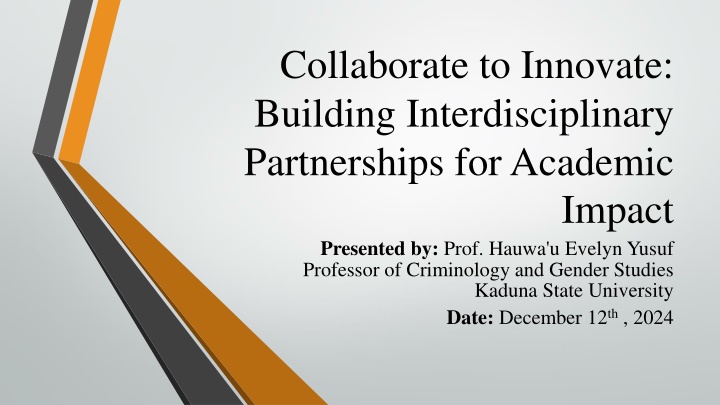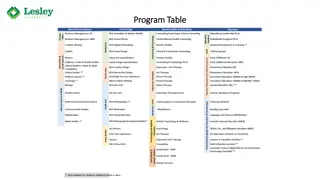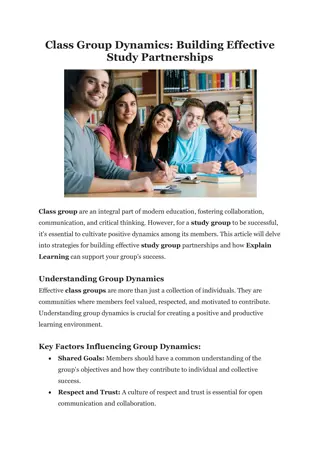
Building Interdisciplinary Partnerships for Academic Impact
In the pursuit of academic excellence, collaboration across disciplines is key. Explore the role of interdisciplinary partnerships in driving innovation, overcoming challenges, and achieving lasting impact in research and teaching. Learn from real-world examples and understand the societal benefits of collaborative efforts in academia.
Download Presentation

Please find below an Image/Link to download the presentation.
The content on the website is provided AS IS for your information and personal use only. It may not be sold, licensed, or shared on other websites without obtaining consent from the author. If you encounter any issues during the download, it is possible that the publisher has removed the file from their server.
You are allowed to download the files provided on this website for personal or commercial use, subject to the condition that they are used lawfully. All files are the property of their respective owners.
The content on the website is provided AS IS for your information and personal use only. It may not be sold, licensed, or shared on other websites without obtaining consent from the author.
E N D
Presentation Transcript
Collaborate to Innovate: Building Interdisciplinary Partnerships for Academic Impact Presented by: Prof. Hauwa'u Evelyn Yusuf Professor of Criminology and Gender Studies Kaduna State University Date: December 12th, 2024
Objectives o To explore the critical role of interdisciplinary partnerships in driving academic innovation and the importance of collaborating with non- academic partners. o To discuss strategies for overcoming challenges in collaboration and ensuring lasting impact in academic research and teaching. o To highlight real-world examples of successful interdisciplinary partnerships and their broader societal benefits
Overview of the Theme Theme Clarification: o Collaborate to Innovate: The central idea of collaboration is working together across academic disciplines and with non-academic partners to foster creative solutions, enhance research, and promote innovation.. o Building Interdisciplinary Partnerships: These partnerships require combining different fields of expertise to address complex societal, academic, and global issues.
Key Focus Areas The importance of collaboration in today s academic landscape. The potential of interdisciplinary partnerships to create a deeper, more comprehensive impact. The ways in which collaborative efforts can drive innovation that transcends traditional academic boundaries. The significance of partnering with non-academic stakeholders to enrich academic projects and ensure practical applicability
The Importance of Collaboration in Academia Why Collaboration Matters: o Increased Knowledge Sharing: Collaboration allows for the exchange of knowledge, best practices, and innovative methodologies. o Bridging Knowledge Gaps: Different academic disciplines bring unique insights to the table. Interdisciplinary work fosters a more comprehensive understanding of complex problems. o Enhancing Problem-Solving Capacity: Many of today s most pressing issues, such as climate change, public health, and social justice, require expertise from various disciplines.
Impact on Global and Local Challenges o Global Health: Researchers from medicine, sociology, and economics working together can better understand and address health crises. o Climate Change: A combination of environmental science, engineering, and urban studies can lead to practical, innovative solutions for sustainability. o Social Justice: Criminologists, gender studies scholars, and human rights advocates working together can tackle issues like systemic inequality
The Power of Interdisciplinary Partnerships What is Interdisciplinary Collaboration? o Involves bringing together experts from multiple fields of study to solve complex problems. o Requires blending perspectives, methodologies, and approaches from various disciplines to generate innovative ideas and solutions.
Examples of Successful Interdisciplinary Partnerships o Public Health and Social Sciences: Health professionals working with sociologists, psychologists, and urban planners to create policies that address both medical and social factors in health crises. o Technology and Education: Collaboration between computer scientists, educators, and psychologists to develop educational technology that is both effective and accessible. o Environmental Sustainability: Environmental scientists, economists, and engineers collaborating to design sustainable urban infrastructure solutions. o Gender Equality partnership: This project is as a result of interdisciplinary partnership.
The Benefits of Interdisciplinary Collaboration Expanded Knowledge Base: o Engaging with different academic disciplines provides a broader knowledge base, encouraging creative and diverse problem-solving. o Researchers from various fields bring different tools and methodologies that enrich the research process. Enhanced Innovation and Creativity: o Collaborating across disciplines fosters new ways of thinking and allows for the development of novel ideas that would not be possible within a single discipline. o The convergence of different approaches often leads to breakthrough innovations.
CONTINUATION Wider Academic and Societal Impact: o Collaboration enables research findings and innovations to have a broader application beyond the academic sphere. Interdisciplinary partnerships can have far-reaching effects on society. o By bringing together different perspectives, interdisciplinary work can directly address the multifaceted nature of many societal issues.
The Challenges of Interdisciplinary Collaboration Communication Barriers: o Different academic disciplines use different terminologies and frameworks, which can create misunderstandings. o The jargon used by professionals from different fields can hinder effective communication, creating silos. Institutional and Structural Barriers: o Many universities have departmental silos that make cross-disciplinary collaborations difficult. o Policies and funding mechanisms may be designed in ways that prioritize traditional disciplines over collaborative approaches.
CONTINUATION OF CHALLENGES Conflicting Objectives and Expectations: o Disciplinary priorities may conflict, making it difficult to align goals, timelines, and outcomes. o Different researchers may have different expectations about the scope and direction of the collaboration. Addressing the Challenges: o Clear Communication: Establishing common language and definitions upfront can reduce misunderstandings. o Shared Goals: Collaborative partners should ensure alignment in objectives, goals, and expected outcomes before initiating projects. o Institutional Support: Institutions must encourage interdisciplinary work through supportive policies, funding opportunities, and collaborative infrastructure.
Steps to Building Successful Interdisciplinary Partnerships Step 1: Identify Common Objectives o Collaboration should begin with a clear understanding of shared goals and objectives. o Define what success looks like from the perspective of each discipline involved. Step 2: Foster Open Communication o Create an environment of transparency where all parties feel comfortable sharing ideas, challenges, and successes. o Establish regular meetings and use collaborative tools like Google Docs or shared project management platforms.
CONTINUATION Step 3: Establish Clear Roles and Responsibilities o Clearly define each team member s role and responsibilities to avoid confusion and overlap. o Acknowledge each discipline s contributions and ensure equitable participation. Step 4: Build Trust and Respect o Foster an inclusive environment where all partners value each other s contributions. o Trust and mutual respect are essential for productive collaboration. Step 5: Leverage Institutional Resources o Utilize institutional funding, administrative support, and research resources to maximize the potential of the partnership.
The Role of Non-Academic Partners in Collaboration Broadening Perspectives: o Non-academic partners bring practical knowledge, real-world experience, and diverse perspectives to academic research. o Their involvement bridges the gap between theoretical insights and practical applications. Expanding Impact: o Collaborative efforts with industries, NGOs, policymakers, and communities can drive societal change beyond academic boundaries. o These partnerships ensure that research addresses real-world problems effectively.
Examples of Non-Academic Collaborations Public Health: o Collaboration with NGOs and government health agencies to implement findings from academic research into public health programs. Technology Development: o Partnerships with tech companies to translate academic innovation into user-friendly applications or products. Community-Based Research: o Working with local communities to co-create solutions for social or environmental challenges, ensuring inclusivity and relevance.
Benefits of Partnering with Non-Academic Stakeholders Real-World Relevance: o Non-academic partners help ensure research outcomes are practical and actionable. Access to Resources: o Partners often provide access to funding, data, or facilities unavailable within academic institutions. Increased Visibility and Impact: o Collaboration with non-academic entities enhances the visibility of research and its direct impact on society.
Challenges in Collaborating with Non-Academic Partners Differing Goals and Priorities: o Academic and non-academic partners may have conflicting timelines or objectives. Communication Gaps: o Non-academic stakeholders may not be familiar with academic jargon, requiring simpler, clearer communication. Navigating Ethical Considerations: o Ensuring that partnerships uphold ethical standards, especially in areas like data sharing, confidentiality, and intellectual property rights.
Strategies for Successful Non-Academic Partnerships Engage Early: o Involve non-academic partners from the project s inception to ensure alignment of goals and expectations. Foster Mutual Respect: o Recognize the expertise and contributions of all partners, valuing both academic and non-academic insights equally. Develop Shared Objectives: o Work together to identify common goals and define success for all stakeholders involved. Leverage Technology: o Use digital tools to facilitate collaboration, monitor progress, and ensure seamless communication between all parties.
Successful Case Studies Case Study 1: Global Health Initiatives o Example:A multi-country health initiative addressing the Ebola outbreak, where medical professionals, sociologists, and political scientists collaborated to both control the epidemic and address social factors such as stigmatization. Case Study 2: Environmental Sustainability o Example: The creation of green cities by urban planners, environmental scientists, and engineers, focusing on sustainable infrastructure, waste management, and renewable energy.
CONTINUATION Case Study 3: Social Justice and Gender Equality o Example: Collaborative work between criminologists, sociologists, and gender studies scholars to create policies that address gender-based violence in the criminal justice system. Case Study : Gender Equality Partnership Grant Key Takeaways: o Interdisciplinary collaboration often leads to solutions that would not be possible in a single-disciplinary context. o Collaboration between diverse fields enhances both the breadth and depth of academic research.
The Role of Technology in Fostering Collaboration Digital Tools for Collaboration: o Communication Platforms: Zoom, Microsoft Teams, and Slack facilitate regular communication among collaborators. o Document Sharing and Collaboration: Google Docs, Dropbox, and Mendeley allow for seamless sharing of resources and research findings. o Project Management Tools: Platforms like Asana, Trello, or Monday.com help manage tasks and deadlines efficiently across teams. Bridging Geographical Gaps: o Technology enables collaboration across borders, creating opportunities for international partnerships that were once limited by physical distance. o Enables real-time collaboration between researchers and scholars from different parts of the world.
Fostering a Collaborative Culture in Academia Promote Interdepartmental Initiatives: o Encourage universities to create programs or initiatives that allow faculty and students to engage in interdisciplinary research projects. Support for Collaborative Grants: o Institutions can create funding opportunities specifically for interdisciplinary research, making it easier for scholars to pursue joint projects. Engage Students in Collaborative Research: o Provide students with opportunities to participate in interdisciplinary research projects, which will help them understand the value of collaboration early in their careers.
Conclusion & Key Takeaways Recognize and Reward Collaborative Efforts: o Institutions should acknowledge and reward interdisciplinary work through funding, promotion, and professional development opportunities. The Key to Innovation: Interdisciplinary collaboration is critical in solving the complex challenges of today s world. By coming together across disciplines, we can create lasting academic and societal impact. Final Thought: o Collaboration fosters innovation, and innovation drives progress. Let s collaborate to create a better future. Call to Action: o Let us continue to build bridges across disciplines, to innovate and create solutions that will shape the future of academia and society.
Q&A Thank you for listening I would now like to open the floor for any questions, comments, or thoughts that you may have on how we can effectively collaborate to innovate in academic and non academic spaces






















